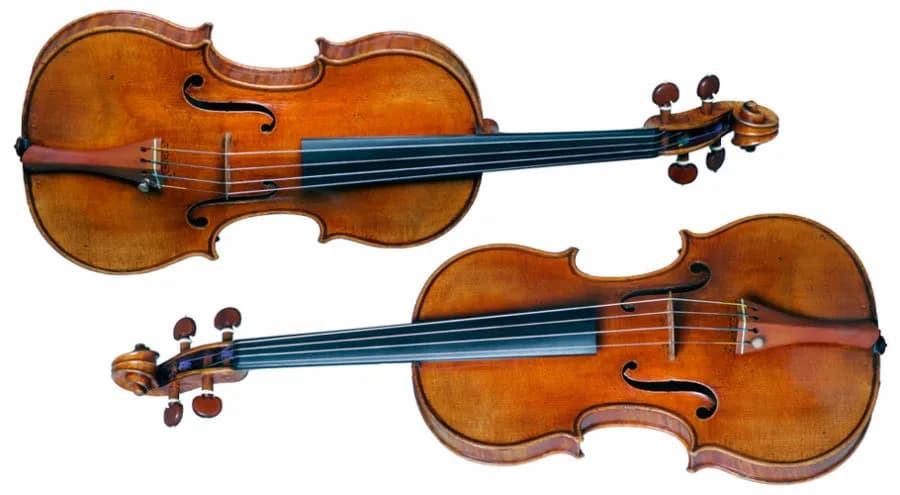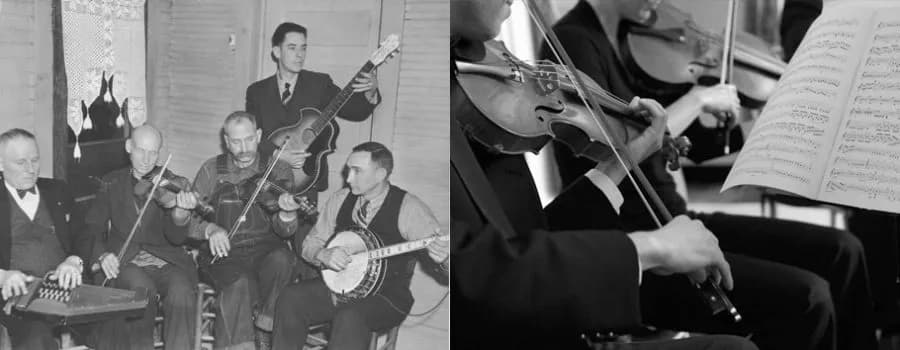The words “violin” and “fiddle” are often used interchangeably to refer to the same thing: i.e., a musical instrument with four strings and played under the chin with a bow.
However, even though the instruments are almost identical, that doesn’t mean that the two words are totally synonymous.

Violins vs. Fiddles © stringsmagazine.com
The word “violin” has specific connotations, and so does the word “fiddle” – and those connotations mean something.
Very broadly speaking, the word “violin” is a more formal term and is most often used when its player is performing classical music.
Meanwhile, the word “fiddle” is a more colloquial term and is often associated with non-classical genres like folk, country, bluegrass, and the like.
Let’s take a closer look at what these two words really mean – and the cultural differences that exist between classical and folk music.
Classical vs. Folk Technique
Classical violinists place great value on precision and control. They have to: some of the music they are asked to play is so difficult, it’s sometimes close to impossible to play.
To ensure the highest level of control and ease, classical violin technique tends to be relatively standardized. It has evolved over centuries and has been adapted to the technical advances of each new generation.
On the other hand, fiddlers often use very different techniques, including unique bowing styles and ornaments that suit the energetic rhythmic demands of folk and traditional music.
But don’t think that fiddlers and folk players have it easy: they require comfort with improvisation and creativity that classical players rarely have.
Hilary Hahn Plays Paganini’s Caprice 24
Different Places for Performances

© stringsmagazine.com
Since violins are most often found in a classical context, you will likely find violinists playing in an orchestra, chamber ensemble, or solo recital setting.
Usually, that means you’ll find them in performance in an auditorium or space built specifically for acoustic music.
Moreover, within these spaces, there are often specific rituals, such as unspoken rules about where applause might occur or the practice of reading a provided printed program about the history of the piece that is about to be played.
Fiddlers, however, are usually found in more casual settings. They’re often found in bands or at festivals, and the concert-going protocol is rarely as uptight.
Raw & Real Old Time Bluegrass Fiddler
Setup and Equipment
Violins used in classical music often have very specific, exacting standards when it comes to craftsmanship, materials, and setup. Those standards help players achieve the ultra-challenging technical goals asked of top-tier classical violinists.
In addition, the violins played by the greatest violinists were usually constructed in Italy in the 1700s, and they can cost millions of dollars.
On the other hand, fiddles used in folk music might have slightly different setups, allowing for brighter and more immediate sound projection that suits the demands of traditional music styles. The brand of string might be different, for instance. The best fiddles don’t need to be from Italy, and certainly not from the 1700s.
Hear a $15 Million Stradivarius
Strings and Tuning
The four strings used on both violins and fiddles are generally tuned at the same pitches (i.e., G, D, A, and E).
However, there are some exceptions.
In classical music, re-tuning the strings is a technique known as scordatura. It might not happen often in the classical music world, but it’s not unheard of. For instance, nineteenth-century French composer Camille Saint-Saëns, in his work Danse Macabre (Macabre Dance), asks the soloist to tune the E-string a half-step lower, to E-flat. That re-tuning creates a spooky mood perfect for the piece.
Camille Saint-Saëns: La danse macabre
Meanwhile, fiddles might also be tuned in alternative tunings to accommodate the specific requirements of different folk styles. Sometimes folk fiddlers re-tune their instruments to tunings that go A, E, A, E or A, D, A, E: tunings that will cause the instrument to ring in a special way. There are other tunings, as well.
How to tune a Hardanger Fiddle
Cultural and Regional Associations

A fiddler at Disneyland © yourclassical.org
The term “fiddle” is often associated with specific regions where folk music and traditional styles hold significance, such as in Celtic, Appalachian, or bluegrass music. There are countless subgenres of folk music that are linked to folk traditions from geographic areas.
Meanwhile, a lot of classical music has been standardized internationally. The most famous soloists all have international careers, and the most prestigious violin performance degrees in European capitals will also prepare a player for a classical career in the United States or Asia.
Appalachian Fiddle Music With Friends
The Role of Sheet Music
Violinists typically play genres like solo concertos to chamber music and orchestral pieces. They learn these pieces by reading sheet music. From an early age, classical musicians are expected to closely follow the composer’s wishes, and alterations are frowned upon as being indulgent or show-offy.
Felix Mendelssohn: Violin Concerto in E
Fiddlers, however, focus on traditional tunes, dance music, and folk songs that have been passed down through generations. They may play from sheet music, but they’ll also likely learn a lot of works by ear. There often isn’t a definitive sheet music of a tune, and any performance is deeply affected by the performer’s collaborators and surroundings. Composers tend to be anonymous, and fiddlers are expected to put their own spin on their performances and put their personalities on display in a way that doesn’t happen quite as often in classical music.
Southern Raised Bluegrass Performs “Orange Blossom Special”
Conclusion
Violins and fiddles may look physically identical. However, the choice of word often reflects the musical style being played and the cultural context in which the instrument is used.
And with all of that said, it’s important to note that the distinction between “violin” and “fiddle” is not always strict.
Some players are equally fluent in both styles and use the same instrument for each. Some string players affectionately call their beloved instruments “fiddles” even if they don’t actually play fiddle music on them. When a fiddler takes lessons, they may well refer to their teacher as their “violin teacher” as opposed to their “fiddle teacher.”
In the end, though, it doesn’t much matter which tradition a player comes from. Whether you’re about to hear an accomplished violinist or an accomplished fiddler, one thing is for certain: you’re in for a treat.
For more of the best in classical music, sign up for our E-Newsletter



